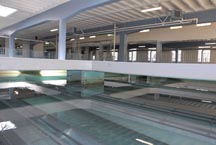
Water is treated in the following process:
Raw WaterThe raw water is first treated in the supply lakes through oxygenation and the addition of ferric chloride to reduce algae growth. The amount of chemicals to be added at the treatment plant is determined by the raw water’s characteristics.
Mixing Basins Chemicals are added as the water enters two rapid mixers: lime for softening and aluminum sulfate as a primary coagulant. Chemical reactions begin to change certain of the hardness compounds in the water from soluble to insoluble precipitates called “floc.” Floc absorbs color and entangles bacteria and other suspended matter. As the floc settles, the hardness is reduced, resulting in finished water hardness of about five grains per gallon (90 parts per million).
FlocculatorsThe water then passes through three basins called flocculators. Large, motor-driven paddles rotate slowly, causing the floc to come into contact with all suspended matter. The long, narrow basins ensure that the softening and coagulation agents have sufficient time to complete the chemical reaction and prevent the floc from settling. Ferric chloride is added as a flocculant aid.
Clarifiers From the flocculators, the water enters into one of five clarifiers. Here, the velocity of the water is reduced, allowing the floc to settle rapidly to the bottom and the clear water to flow over the top of the basin. The settled floc is called spent lime and eventually flows to the dewatering plant, where the solids are separated and the remaining water content is recycled to the plant. The solid lime is trucked out for agricultural use.
Recarbonation Chamber As the water flows out of the clarifiers, it enters the recarbonation basin. Carbon dioxide gas is added to lower the pH of the water. Fluoride is also added in this chamber, which improves dental health.
 Filters Water is then distributed to 24 filter units. Each filter has a bed of filter media 40 inches deep, consisting of 36 inches of granular activated carbon (GAC) on top of 4 inches of sand. Gravity pushes water through the filter and any remaining particulate matter is trapped in the filter. These filters remove particles as small as protozoa, and as such, provide a barrier against organisms such as Cryptosporidium and Giardia. The GAC filter media also remove taste and odor compounds from the water, helping it taste better. Filtered water is collected from the bottom of each filter and routed to the disinfection step.
Filters Water is then distributed to 24 filter units. Each filter has a bed of filter media 40 inches deep, consisting of 36 inches of granular activated carbon (GAC) on top of 4 inches of sand. Gravity pushes water through the filter and any remaining particulate matter is trapped in the filter. These filters remove particles as small as protozoa, and as such, provide a barrier against organisms such as Cryptosporidium and Giardia. The GAC filter media also remove taste and odor compounds from the water, helping it taste better. Filtered water is collected from the bottom of each filter and routed to the disinfection step.
Disinfection Chlorine is then added to kill bacteria and virus. Free chlorine is in contact with the water for a period of time; then ammonia is added to react with the chlorine. This combined chlorine/ammonia compound is called chloramine. Chloramine is more stable than free chlorine, and allows for disinfectant to remain in the water even at the far reaches of our distribution system. Chloramine is also less likely to form unwanted disinfection by-products.